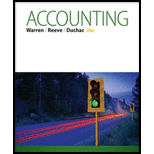
Accounting (Text Only)
26th Edition
ISBN: 9781285743615
Author: Carl Warren, James M. Reeve, Jonathan Duchac
Publisher: Cengage Learning
expand_more
expand_more
format_list_bulleted
Question
Chapter 8, Problem 8.6EX
To determine
Internal Control: Internal control refers to the policies, and plans of the business organization along with other measures with a view to safeguard its assets, encourage the employees to adhere to the plans, to improve on the operational efficiency, and to ensure correct and reliable accounting information. Internal control is a process which ensures continuous reliability of accomplishment of a company’s objectives, related to operations, financial reporting, and in conformity with laws and regulations.
The following are the some of the internal control procedures:
- Competent personnel, rotating duties, and mandatory vacations
- Separating responsibilities for related operations
- Separating operations, custody of assets, and accounting
- Proofs and security measures
To state: the reasons for discovering the fraud very late.
Expert Solution & Answer
Trending nowThis is a popular solution!

Students have asked these similar questions
Bella Brands operates with two divisions, Aftershave and Deodorant. The Aftershave Division produces a chemical that the Deodorant Division also uses. The Aftershave Division also sells this chemical to other firms for $10 per ounce. The cost information for the Aftershave Division is as follows:
Variable costs per ounce
$ 6.00
Fixed costs per ounce
$ 15.00
Monthly production capacity
30,000
ounces
If the Aftershave Division is not operating at full capacity and is able to supply the Deodorant Division with its needs for the chemical, what is the minimum transfer price that the Aftershave Division will accept?
Multiple Choice
None of the choices is correct.
$10.00 per ounce
$6.00 per ounce
$15.00 per ounce
$3.00 per ounce
Brar Incorporated supplied the following financial information for analysis:
Depreciable assets (purchased at the beginning of year 1)
$ 4,500,000
Profits before depreciation (all in cash flows at end of year):
Year 1
960,000
Year 2
1,400,000
Year 3
2,100,000
Replacement cost of depreciable assets at end of:
Year 1
$ 5,000,000
Year 2
6,200,000
Year 3
7,600,000
The assets are depreciated at a rate of 12% per year and have no salvage value. What is the ROI for year 2 using historical cost, net book value?
Multiple Choice
26.60%
24.72%
25.15%
22.64%
None of these.
Bella Brands operates with two divisions, Aftershave and Deodorant. The Aftershave Division produces a chemical that the Deodorant Division also uses. The Aftershave Division also sells this chemical to other firms for $27 per ounce. The cost information for the Aftershave Division is as follows:
Variable costs per ounce
$ 6.00
Fixed costs per ounce
$ 15.00
Monthly production capacity
30,000
ounces
If the Aftershave Division is operating at full capacity and can sell all of the chemical that it can produce, what is the minimum transfer price that the Aftershave Division will accept?
Multiple Choice
None of the choices is correct.
$6.00 per ounce
$21.00 per ounce
$15.00 per ounce
$27.00 per ounce
Chapter 8 Solutions
Accounting (Text Only)
Ch. 8 - Prob. 1DQCh. 8 - Why should the employee who handles cash receipts...Ch. 8 - Prob. 3DQCh. 8 - Why should the responsibility for maintaining the...Ch. 8 - Prob. 5DQCh. 8 - Prob. 6DQCh. 8 - The balance of Cash is likely to differ from the...Ch. 8 - Prob. 8DQCh. 8 - Prob. 9DQCh. 8 - (a) How are cash equivalents reported in the...
Ch. 8 - Internal control elements Identify each of the...Ch. 8 - Prob. 8.1APECh. 8 - Prob. 8.2BPECh. 8 - Prob. 8.2APECh. 8 - Prob. 8.3APECh. 8 - Prob. 8.3BPECh. 8 - Prob. 8.4APECh. 8 - Prob. 8.4BPECh. 8 - Prob. 8.5APECh. 8 - Prob. 8.5BPECh. 8 - Sarbanes-Oxley internal control report Using...Ch. 8 - Prob. 8.2EXCh. 8 - Prob. 8.3EXCh. 8 - Prob. 8.4EXCh. 8 - Prob. 8.5EXCh. 8 - Prob. 8.6EXCh. 8 - Prob. 8.7EXCh. 8 - Prob. 8.8EXCh. 8 - Prob. 8.9EXCh. 8 - Prob. 8.10EXCh. 8 - Prob. 8.11EXCh. 8 - Prob. 8.12EXCh. 8 - Prob. 8.13EXCh. 8 - Internal control of cash payments Abbe Co. is a...Ch. 8 - Prob. 8.15EXCh. 8 - Prob. 8.16EXCh. 8 - Prob. 8.17EXCh. 8 - Prob. 8.18EXCh. 8 - Prob. 8.19EXCh. 8 - Prob. 8.20EXCh. 8 - Prob. 8.21EXCh. 8 - Prob. 8.22EXCh. 8 - Prob. 8.23EXCh. 8 - Prob. 8.24EXCh. 8 - Prob. 8.25EXCh. 8 - Cash to monthly cash expenses ratio El Dorado Inc....Ch. 8 - Prob. 8.27EXCh. 8 - Prob. 8.28EXCh. 8 - Prob. 8.1APRCh. 8 - Prob. 8.2APRCh. 8 - Prob. 8.3APRCh. 8 - Prob. 8.4APRCh. 8 - Prob. 8.5APRCh. 8 - Prob. 8.1BPRCh. 8 - Prob. 8.2BPRCh. 8 - Prob. 8.3BPRCh. 8 - Prob. 8.4BPRCh. 8 - Prob. 8.5BPRCh. 8 - Ethics in Action During the preparation of the...Ch. 8 - Prob. 8.2CPCh. 8 - Prob. 8.3CPCh. 8 - Prob. 8.4CPCh. 8 - Prob. 8.5CPCh. 8 - Prob. 8.7CP
Knowledge Booster
Similar questions
- Please provide the accurate answer to this financial accounting problem using appropriate methods.arrow_forwardI am searching for the accurate solution to this general accounting problem with the right approach.arrow_forwardCan you help me solve this general accounting question using the correct accounting procedures?arrow_forward
- Can you help me solve this general accounting question using the correct accounting procedures?arrow_forwardI need help solving this general accounting question with the proper methodology.arrow_forwardI need the correct answer to this general accounting problem using the standard accounting approach.arrow_forward
arrow_back_ios
SEE MORE QUESTIONS
arrow_forward_ios
Recommended textbooks for you
- Business/Professional Ethics Directors/Executives...AccountingISBN:9781337485913Author:BROOKSPublisher:Cengage
 Financial And Managerial AccountingAccountingISBN:9781337902663Author:WARREN, Carl S.Publisher:Cengage Learning,
Financial And Managerial AccountingAccountingISBN:9781337902663Author:WARREN, Carl S.Publisher:Cengage Learning,

Business/Professional Ethics Directors/Executives...
Accounting
ISBN:9781337485913
Author:BROOKS
Publisher:Cengage

Financial And Managerial Accounting
Accounting
ISBN:9781337902663
Author:WARREN, Carl S.
Publisher:Cengage Learning,
